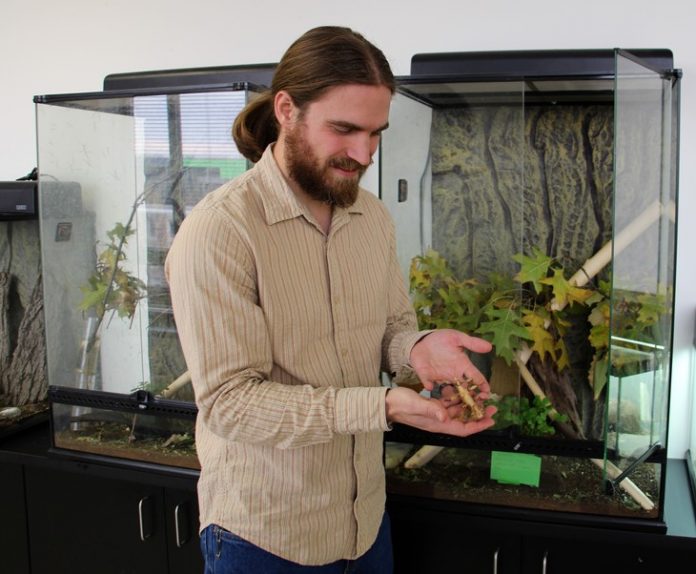
UNIVERSITY PARK, Pa. — With more than a million different species of insects in the world, it is no wonder that bugs “bug” us.
One person who does not flinch when insects are nearby is Michael Skvarla, director of the Insect Identification Lab in Penn State’s College of Agricultural Sciences, whose work helps folks co-exist better with their creepy-crawly neighbors, which, by the way, outnumber humans 200 million to 1, according to some estimates.
“What is so interesting is that we’ve only scratched the surface when it comes to identifying and naming all species of insects — there are millions more we have yet to discover,” he said.
“Insects are one of the most diverse group of organisms and have a great impact on our ecosystem.”
Fascinated with bugs
His fascination with insects began nearly 25 years ago when he was tasked with creating a collection of his choosing for a Cub Scout project.
When his father suggested insects, Skvarla was puzzled — it was February — he could not imagine how they would find bugs.
Nevertheless, the pair ventured into the woods near their home outside of Pittsburgh, and, after hiking for a bit, came across a tree that piqued the older Skvarla’s interest.
They pulled back a piece of its bark and — to the youngster’s surprise — discovered a nest of hibernating wasps. “I couldn’t believe we found bugs in the middle of winter,” Skvarla said. “From that point on, I was hooked.”
After earning a bachelor’s degree from Purdue University followed by master’s and doctoral degrees in entomology from the University of Arkansas, Skvarla joined the Department of Entomology at Penn State in May.
He spends his days identifying specimens from ants to wasps and everything in-between, which have been submitted by Pennsylvania’s agricultural producers, gardeners and homeowners.
Identifying insects
He said most insects pose no threat, other than being annoying. In fact, many serve an important purpose, such as bees and butterflies, which help to pollinate plants.
Others are not so helpful — including herbivorous beetles and grasshoppers — as they feast on leaves and other plant parts and can damage food crops and flowerbeds.
One very destructive insect that has been in the news lately is the spotted lanternfly — a species that is native to parts of China and eastern Asia.
Its arrival in Pennsylvania presents a significant threat to fruit orchards and grape vines, along with forests and the timber industry, according to Skvarla, who noted that Penn State is on the forefront of efforts to stop the spread of this invasive pest.
Finally, there are insects that are dangerous to health. In Skvarla’s opinion, the worst of these is the disease-carrying mosquito, which infects millions each year with malaria and other maladies.
Ticks are second on his most-dangerous list, carrying a variety of serious diseases, most notably Lyme disease in Pennsylvania.

Reporting dangerous species
When a dangerous or destructive species comes across his desk, he notifies the state Department of Agriculture because “early reporting is crucial in preventing the spread of insects that threaten public health, food crops and the environment.”
For the layperson, knowing which insects are good and which are not can be perplexing, and that is where Skvarla can help.
“Once you know what you’re dealing with, then you can react effectively,” he said. “My goal is to help people make informed decisions — you don’t have to spray everything with a pesticide.”
Actually, many people prefer to use non-chemical methods or the minimum amount of pesticide possible, he noted.
In agriculture, for example, growers sometimes can use cultural methods (changing the environment) or even beneficial insects that are natural predators of the pest insect.
Identification services
Identification services are provided free-of-charge to Pennsylvania residents. Specimens can be taken to county Penn State Extension offices, where extension personnel often can identify an insect on the spot.
If the specimen is difficult to identify, local extension educators will forward the sample to the Insect Identification Laboratory.
In addition, samples may be mailed to Skvarla at: Insect Identification Laboratory, 501 Agricultural Sciences and Industries Building, University Park, PA, 16802.
He suggested preparing specimens for mailing by placing them in a small vial filled with rubbing alcohol and placing the vial in a plastic sandwich bag.
It is also important to include an address and phone number, as well as some information about the insect, such as where it was found. Skvarla’s goal is to identify a specimen within a few days of receiving it.
“I’m excited to be at Penn State and to use my knowledge to help others have a better understanding of the insects that share the planet with us,” he said.
Resources
Fact sheets about various insects, an insect image gallery and other resources can be found on the Department of Entomology website.
A list of county extension offices is available here.
Spotted lanternfly sightings should be reported directly the state Department of Agriculture here.









